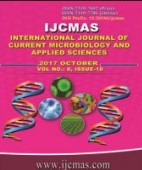


 National Academy of Agricultural Sciences (NAAS)
National Academy of Agricultural Sciences (NAAS)

|
PRINT ISSN : 2319-7692
Online ISSN : 2319-7706 Issues : 12 per year Publisher : Excellent Publishers Email : editorijcmas@gmail.com / submit@ijcmas.com Editor-in-chief: Dr.M.Prakash Index Copernicus ICV 2018: 95.39 NAAS RATING 2020: 5.38 |
The study was carried out for 210 days to compare the growth, survival, production and economic performance of Pangasianodon hypophthalmus in cages and ponds. The fingerlings of P.hypophthalmus (71.47 ± 0.84 g wt. and 18.83 ± 0.52 cm length) were stocked at 50, 60 and 70 fingerlings/m3 in nine cages (6 x 4 x 3 m3) and they were stocked at 5, 6 and 7 fingerlings/m3 in nine ponds (50 x 30 m2 and 1.2 m depth) following three treatments with triplicates for both cages and ponds. Fish were fed with commercial feed (32% protein, Growel Feeds Pvt. Ltd.) initially at the rate of 5 % of body weight to 1.75% of body weight at the end of the culture period. At the end of the experiment, average growth of P. hypophthalmus was recorded higher in cages (1026.87 ± 7.48 g and 46.25± 0.94 cm) as compared to ponds (975.84 ± 7.21g and 45.06 ± 0.79 cm) in terms of final body weight and length. Likewise the specific growth rate (SGR) was also higher in cages (1.27 ± 0.007) than ponds (1.25 ± 0.008). The survival of fish showed better performance in cages (90.91 ± 0.93 %), when compared to ponds (78.0 ± 0.87 %). The production per unit volume recorded was much higher in cages (55.91 ± 0.47 kg/m3) than ponds (4.56 ± 0.04 kg/m3) and therefore, net profit per unit volume achieved was too higher in cages (₹ 1254.00 ± 24.12 /m3) than ponds (₹ 57.50 ± 0.89 /m3). The better feed conversion ratio (FCR) was achieved in ponds (1.47 ± 0.01) when compared to cages (1.63 ± 0.011) whereas, the benefit cost ratio (BCR) was found better in cages (1.36 ± 0.004) than ponds (1.28 ± 0.002). The benefit-cost analysis of this study suggests for adoption of cage culture, as it is more profitable than pond culture.
 |
 |
 |
 |
 |